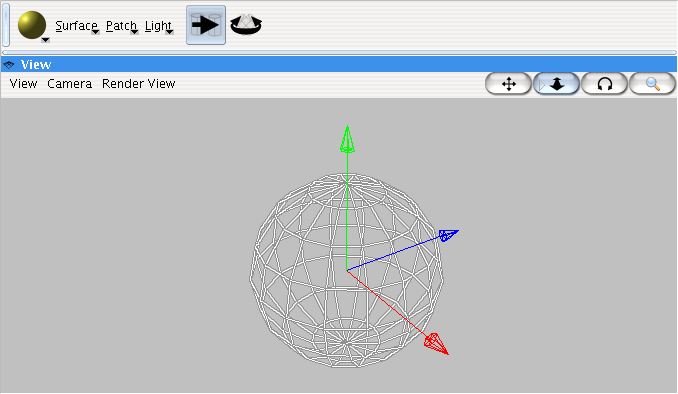Table of Contents
Modify object in the scene
Figure 1
The currently selected object can also be modified by 3D tools. GroIMP has three tools for modifying a selected object in the scene:
- The translation tool: in Figure 1, you can see three arrows which are the handles for GroIMP's 3D translation tool. By dragging the arrows with the mouse, the object is moved along the arrow direction. If you use the middle mouse button for dragging, the movement is in a plane perpendicular to the arrow direction.
- The rotation tool: It is activated in the toolbar by clicking on the rotation icon. As handles, it displays three circles which can be dragged to rotate the selected object.
- The scaling tool: It change the scale of an object toward one axis.
Pressing the del key will delete the selected objects.
Navigate in the scene
Navigation in the view panel is possible with the navigation buttons in the view panel's upper right corner or with the mouse. To navigate using the buttons, press a button and drag with the mouse while keeping the button pressed. To navigate using the mouse only, press the Shift button and drag with the mouse over the view panel: The left mouse button rotates the view, the middle mouse button moves the viewpoint in the viewing plane, and the right mouse button makes a dolly movement along the viewing direction (or a zoom for a view camera with parallel projection). The mouse wheel works similarly to the right mouse button.
The Camera menu of GroIMP's 3D view allows the selection of different cameras. Some cameras are predefined, among them the common orthographic projections. You can add user-defined cameras to your project in the Camera Explorer (the menu item Panels/Object Explorers/3D/Cameras brings it up); these cameras can be selected as current camera in the Camera menu, too. They can be edited through the navigation facilities or in the Attribute Editor.
See more:
Select objects
You can select object by clicking on them. It is possible to hold CTRL and select multiple objects.
See more:
Add objects
It is possible to add objects in the scene by clicking on Objects, then, one of:
- From file
- Primitives
- NURBS
- Polygonal
- Scene objects
See more:
Change the default display
GroIMP features OpenGL-accelerated display of the scene. The OpenGL-based display may be selected if the Java Binding for the OpenGL API (JOGL) is installed. The menu View/Display of GroIMP's 3D view brings up the selection for the different supported display modes. These are:
- Wireframe (AWT): A wireframe view of the scene. Will run on all systems.
- OpenGL: OpenGL-based view. Will run on all systems with OpenGL 1.1 support. This mode will display colors and simple textures.
- OpenGL (Proteus): OpenGL-based view. Requires a OpenGL 2.1 compatible GPU. This mode will preview the output of the internal raytracer Twilight in realtime. It features:
- Preview of most materials including procedurally calculated shaders using the OpenGL Shading Language (GLSL)
- Per pixel lighting
- Rendering of shadows
- Preview of Sky-Nodes as background
- Rendering of transparent materials
Navigation and control is the same for the Wireframe and both OpenGL-based modes as explained in how to navigate in the scene. A comparison of all three modes for an example scene is shown in figure 2.
Figure 2 Comparison of GroIMP's 3D view modes
See more:
Render the scene
You can render the current scene with the Render View menu item.
GroIMP embed two default renderer:
- Twilight, based on the main Ray tracer (see this page for more details)
- Fluxrenderer, based on GPUFlux (see this page for more details)
Additionally it is possible to add external renderer in GroIMP. Currently the only external renderer is:
- POV-Ray, a free ray-tracer, which can be used to render 3D scenes in high quality (see here for more info)
See more:


